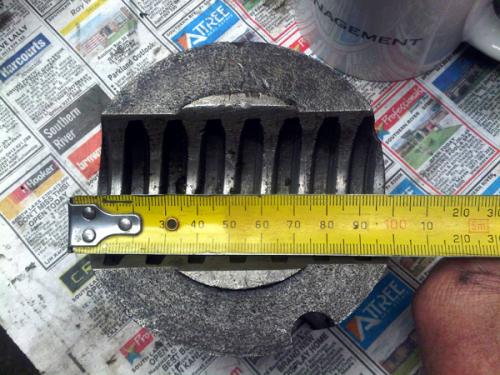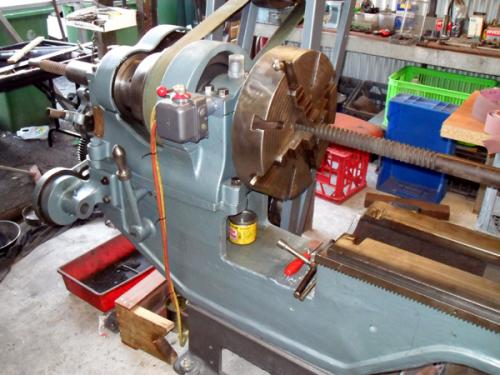Posts: 2,685
Threads: 29
Joined: Feb 2012
Location: Nova Scotia, Canada
09-02-2012, 07:16 AM
(This post was last modified: 09-02-2012, 07:17 AM by stevec.)
(09-01-2012, 10:44 PM)Mayhem Wrote: I had originally been told that as my leadscrew is 2tpi,
Mayhem, I'm certainly not "calling" you on this but I'm having trouble picturing a leadscrew of 2 tpi. The leadscrew on my 16 x 60 is 1.5" in Dia. and it's pitch is 4 TPI and I'm trying to picture the helix of 2 tpi.
What's the Dia. of your leadscrew? 
Busy Bee 12-36 lathe, Busy Bee Mill drill, Busy Bee 4x6 bandsaw, Homemade 9x17 bandsaw, Ad infinitum.
Posts: 4,683
Threads: 93
Joined: Feb 2012
Location: Perth, Australia
(09-02-2012, 07:16 AM)stevec Wrote: Mayhem, I'm certainly not "calling" you on this but I'm having trouble picturing a leadscrew of 2 tpi. The leadscrew on my 16 x 60 is 1.5" in Dia. and it's pitch is 4 TPI and I'm trying to picture the helix of 2 tpi.
What's the Dia. of your leadscrew? 
I'll have to go and measure it Steve but here is a photo of one of the half nuts from when I stripped her down:

Here is a pic showing the leadscrew when I had it chucked up to clean it but it isn't the best.

Hunting American dentists since 2015.
Posts: 4,493
Threads: 187
Joined: Feb 2012
Location: Missouri, USA
(09-02-2012, 05:35 AM)Hopefuldave Wrote: Often the dial's attached to the gear's shaft with a friction fit, so for long, fine, odd-or-half-tpi threads you can rotate it to bring a number up approaching the index mark before you start threading - this can save a lot of time!
Dave H. (the other one)
Dave brings up a good point here. At one time I started having a problem with not being able to engage the half-nuts on my lathe when the dial marks came around. They would only fall in ahead of, or behind the dial markings.
Then I discovered the bolt that holds the drive gear on the dial shaft had loosened up and allowed the gear to turn on the shaft a bit. The gear is not keyed to the shaft.
Engaging the half-nuts on the feed screw (lathe off) I turned the dial by hand until one of the marks lined up, and then re-tightened the bolt holding the gear in place. Problem solved. 
Willie
Posts: 168
Threads: 6
Joined: Mar 2012
Location: Surrey, England
Looking at the pics, it's pretty definitely 2 tpi... A lot of older lathes had relatively coarse leadscrews as most of the threads they had to cut were pretty coarse too :)
If you're making a nice new numbered dial with a friction fit to replace the old centre-punched one, maybe it'll be worth knurling the edge for adjustments?
================== Probably unwanted info starts here ==========
If you're making a new gear too it's probably going to want to be 16 teeth, as an 8-tooth gear will have some funny tooth shapes and quite a pronounced helix... even a straight-cut 16-tooth gear gets tricky with a 14.5-degree pressure angle!
Some calculations for the gear (if you need to):
Assuming you have a 29-degree Acme leadscrew so want 14/5-degree pressure-angle gears - bear in mind this is a "rough" gear, you'd have some errors creeping in from setting it over to match the helix angle of the leadscrew... Using something soft like brass, aluminium, delrin or nylon would be a good idea, the gear would wear instead of the leadscrew...
The gear won't be a particular whole-number diametral pitch (the pitch will be 1/2" *circular*), you could calculate it as Pi/(a half) or 2 pi DP - not an off-the-shelf gear!
the initial diameter of the gear blank would be (teeth + 2)/2 pi - so for a 16-tooth, 18/(2 pi), OD = 2.865" - you could reduce this a touch for clearance without much of a problem.
If your leadscrew has a keyway and the gear's made of something *soft*, you could then "gash" the gear blank for the 16 tooth spaces and slowly feed it (rotating on a bearing) in against the rotating leadscrew, it'd cut its own tooth profile?
If not, a hob copying the leadscrew (diameter, pitch and thread form) and fluted like a tap will do a very good job if run in the lathe with the (gashed) gear blank free-running against it.
======================= End of unwanted info ==============
Interesting piece of vintage iron, that - the back-gear cover looks very familiar, but I can't place it...
Dave H. (the other one)
Rules are for the obedience of fools, and the guidance of wise men...
(Douglas Bader)
Posts: 275
Threads: 12
Joined: Mar 2012
Location: Nebraska, USA
Someone double-check me on this...
Looking at the pic with the tape measure starting at the "60" mark and reading to the left I'm reading 23mm for two "turns". When I do a conversion 1" = 25.4mm, so if that is supposed to be a 2 tpi thread something would seem to be off or are we dealing with a metric thread?
Thanks,
-Ron
11" South Bend lathe - Wells-Index 860C mill - 16" Queen City Shaper
Posts: 4,683
Threads: 93
Joined: Feb 2012
Location: Perth, Australia
09-04-2012, 08:16 AM
(This post was last modified: 09-04-2012, 08:30 AM by Mayhem.)
Hunting American dentists since 2015.
Posts: 266
Threads: 23
Joined: Feb 2012
Location: OLDS, ALBERTA
Interesting old lathe, that gear on the thread dial sure looks to be thin especially compared to my lathe. tom
Logan 10x26" lathe
SIEG 12x40" lathe
RongFU 45 clone mill
6" import band saw
Baldor Grinder
thousand of tools+tooling pieces 40 yrs of collecting
Posts: 258
Threads: 13
Joined: Aug 2012
Location: USA
It probably just looks thin in comparison to the rest of the massively oversized parts  I was thinking the same thing though.
SnailPowered, proud to be a member of MetalworkingFun since Aug 2012.
Posts: 1,827
Threads: 51
Joined: Apr 2012
Location: Oklahoma
might be a replacement someone filed out of thin brass stock.
dallen, proud to be a member of MetalworkingFun Forum since Apr 2012.
If life seems normal, your not going fast enough! 
Posts: 2,685
Threads: 29
Joined: Feb 2012
Location: Nova Scotia, Canada
Is the apparent tilt of the threading dial axis actually there or is it some kinda distortion of the pic.
If so it appears to me to be tilted in the wrong direction. Both dials on my machines axis are 90° to the leadscrew.
I agree with dallen's thought, that the gear may have been cobbled up by a previous owner. Maybe long after cleaning out the chip pan the operator/owner noticed the original gear had fallen off.
Busy Bee 12-36 lathe, Busy Bee Mill drill, Busy Bee 4x6 bandsaw, Homemade 9x17 bandsaw, Ad infinitum.
|







 I was thinking the same thing though.
I was thinking the same thing though.
